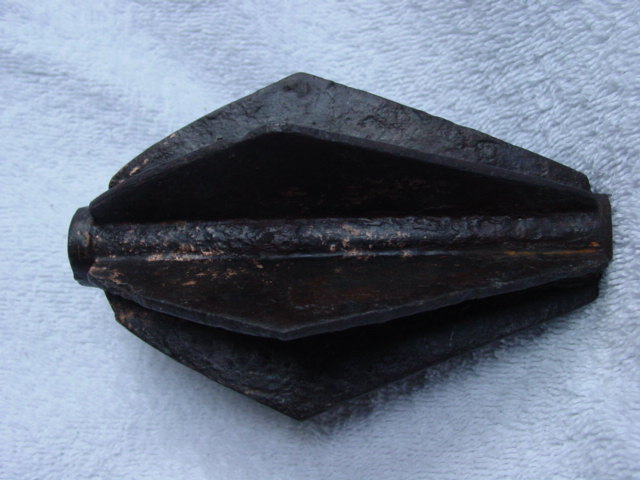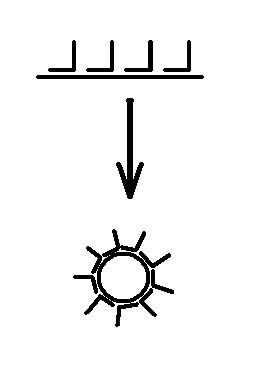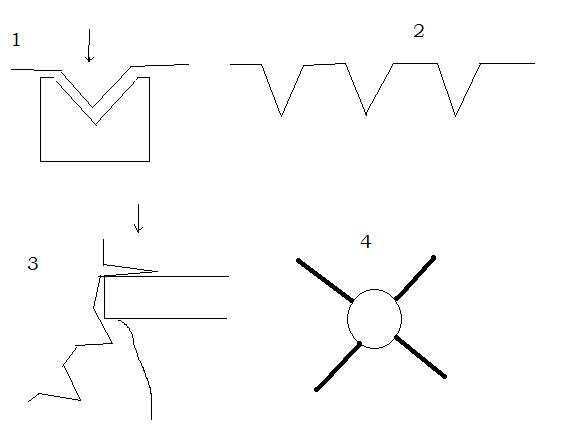iīm from Portugal....and i built replicas of swords and daggers from X to XVI cent......i would like to ask if someone can help mein a question............how did they make the maces of blades..... thank you!
Hello Jorge, and welcome to the forum. I think you are describing a flanged mace head like the one below, is that correct? I've often wondered about this myself.
By the way this is a great source for mace information (and it is where I got the image)
http://otlichnik.tripod.com/medmace3.html
 Attachment: 60.89 KB
Attachment: 60.89 KB

By the way this is a great source for mace information (and it is where I got the image)
http://otlichnik.tripod.com/medmace3.html

hello gavin....!!!!! thank you for the reply...... yes youīr right thatīs the type of mace!....and the problem is....how did they do this weapon..... the blades are temperated steel.!!! so they could not make the piece by casting the iron....welded????? i d 'ont think so.....there's no way....!!!! i've tried before...the steel loses the temper.....it's a real mystery....all the other weapons are possible to reproduce......but the mace......itīs the big challenge!!!!
| Jorge Santos wrote: |
| hello gavin....!!!!! thank you for the reply...... yes youīr right thatīs the type of mace!....and the problem is....how did they do this weapon..... the blades are temperated steel.!!! so they could not make the piece by casting the iron....welded????? i d 'ont think so.....there's no way....!!!! i've tried before...the steel loses the temper.....it's a real mystery....all the other weapons are possible to reproduce......but the mace......itīs the big challenge!!!! |
Jorge,
I wondered the same thing for a long time. The flanges were brazed on. Think about it and it's about the only thing that makes sense besides casting. You can even see the copper in the seams on the above picture.
Cheers,
Matt
hello mathew.......and welcome to the discussion............ yes in the case of the mace in the picture ,,,you'r rigth........there's copper alright.....but i've seen others were theres no trace of copper....or any kind of welding.......and thatīs wath makes me crazy!!!!!!!!!!!!!......see book " WEAPON"....Richard Holmes...in association with ROYAL ARMOURIES MUSEUM.....page 137 and you'l l see wath i mean.....cheers..
Jorge,
Thank you for the welcome. Keep in mind they've found bronze-age rings that required a microscope to find where it was brazed together (I often find those bronze age guys were a lot cleverer than I.) Without the piece in your hand it may be difficult to see any signs of brazing. The only other thing that I can imagine is dovetailing it in, but dismissed it as too much work when you can just braze and have a very high tensile strength.
I've chewed the issue over with two other blacksmiths and it has been the only thing has made sense. Maybe someone else here has a better theory?
Cheers!
Matt
Thank you for the welcome. Keep in mind they've found bronze-age rings that required a microscope to find where it was brazed together (I often find those bronze age guys were a lot cleverer than I.) Without the piece in your hand it may be difficult to see any signs of brazing. The only other thing that I can imagine is dovetailing it in, but dismissed it as too much work when you can just braze and have a very high tensile strength.
I've chewed the issue over with two other blacksmiths and it has been the only thing has made sense. Maybe someone else here has a better theory?
Cheers!
Matt
Jorge this has puzzled be for some time, and the only method that I can come up with I have illustrated below. I'm sure there is some method that I would never imagine that was actually used, but I think I could make this work.
Step 1: Hammer weld L shaped flanges onto a flat sheet.
Step 2: Bend the sheet around into a tube.
Step 3: Hammer weld the edges of the sheet
 Attachment: 6.91 KB
Attachment: 6.91 KB

Step 1: Hammer weld L shaped flanges onto a flat sheet.
Step 2: Bend the sheet around into a tube.
Step 3: Hammer weld the edges of the sheet

I like Gavin's idea and wouldn't be surprised if it had been tried at some stage, but I'd have to say that in almost every case, the flanges were brazed to the shaft.
Jorge, you're right in thinking that this would prevent hardening of the steel. Fortunately, a mace doesn't have the same requirements as a sword, for example, and really doesn't need to be hardened.
Jorge, you're right in thinking that this would prevent hardening of the steel. Fortunately, a mace doesn't have the same requirements as a sword, for example, and really doesn't need to be hardened.
Yup, that would do it Gavin. Never thought of that. Very cool.
Matt
Matt
Brazing may have been a very popular way of putting the flanges on, but do not count out welding.
The welding I am speaking of is forge welding. Our ancestors were working with wrought iron, and steeling it. Compared to modern steels it welds like a dream. There is even a type of welding referred to as pinch welding, where the pieces are broungt up to welding temperature in the forge and literally pinched or squeezed together while still in the fire, instead of being hammered. While pinch welding can be done with modern steels, it is difficult. Wrought iron can actually take temperatures that allow the scale to melt away, and then can be joined in the fire without flux, and into a seam that has full strength.
Hardening and tempering of the flanges would have been done last, once the head was together, so the temperatures used during welding would not remove the temper, as the temper wasn't there yet.
Ken Nelson
Iron Wolf Forge
The welding I am speaking of is forge welding. Our ancestors were working with wrought iron, and steeling it. Compared to modern steels it welds like a dream. There is even a type of welding referred to as pinch welding, where the pieces are broungt up to welding temperature in the forge and literally pinched or squeezed together while still in the fire, instead of being hammered. While pinch welding can be done with modern steels, it is difficult. Wrought iron can actually take temperatures that allow the scale to melt away, and then can be joined in the fire without flux, and into a seam that has full strength.
Hardening and tempering of the flanges would have been done last, once the head was together, so the temperatures used during welding would not remove the temper, as the temper wasn't there yet.
Ken Nelson
Iron Wolf Forge
From my review of the Windlass Steelcrafts German Mace:
"Historically, it seems that these often were brazed to a separate piece of metal and then attached to the shaft as a single piece. Alternately, they were attached by projections in their bases that corresponded to holes in the shaft, then secured in place by brazing."
If I remember correctly, that's according to Oakeshott.
This could explain cases in which we don't see the brazing--it's inside the shaft (?).
"Historically, it seems that these often were brazed to a separate piece of metal and then attached to the shaft as a single piece. Alternately, they were attached by projections in their bases that corresponded to holes in the shaft, then secured in place by brazing."
If I remember correctly, that's according to Oakeshott.
This could explain cases in which we don't see the brazing--it's inside the shaft (?).
Running with Gavin's idea you could also:
1) Hammer 4 v-shapes into a swage so it looks like #2
3) Forge weld the "V"s down
4) Wrap it around and weld it like they would a pipe.
Sorry the drawing is a little crude. Drawing with a mouse is like drawing with a brick.
Matt
 Attachment: 15.08 KB
Attachment: 15.08 KB

1) Hammer 4 v-shapes into a swage so it looks like #2
3) Forge weld the "V"s down
4) Wrap it around and weld it like they would a pipe.
Sorry the drawing is a little crude. Drawing with a mouse is like drawing with a brick.
Matt

I'm glad this topic came up. I wasn't really familiar with brazing, and certainly would have thought it a modern technique.
I'm also glad that someone likes my idea even if it isn't historical :D
I'm also glad that someone likes my idea even if it isn't historical :D
Hello people!!!!! and thank you all for the help you give me.......your fantastic!!!!! .....Sean...what you say makes sense....!! i'm going to try that...... i guess now we are thinking like a midlle age swordsmith would do and following the same steps when they tried to make the first mace....and we are facing the same problems they had before finding the right way to do it..............a big...embrace to you all....and now ...........let's make the envil sing!!!!
Hello Austin!!!!!............thank you for your reply.....! but i'm afraid i can not agree with you.... i can assure you that maces were hardened....!!!! i have the fortune of had some original pieces in my hands ....for study...and they were hardened allrigth...that i'm certain.... cheers... Jorge Santos
Hello Gavin.............just to say that i find your idea very interesting......that could really work !!!!!...maybe you found it!!!!.........thank you for the suggestion............ cheers to you!
Hi Jorge
Ou of curiosity, how do you know the maces you handled were hardened ?
Most - if not all - maces I saw had the flanges brazed on BTW. Copper brazing the said flanges required a great mastery of the brazing process and work enironment.
Ou of curiosity, how do you know the maces you handled were hardened ?
Most - if not all - maces I saw had the flanges brazed on BTW. Copper brazing the said flanges required a great mastery of the brazing process and work enironment.
Hello fabrice....!!!!..your question is interesting.... all along the past years iīve built many swords and daggers too...... i work with my forge and my envil and in my case i can feel the hardened steel by the touch and the sound of the metal if you give a gentle touch using a small hammer.... but there are other ways......with a pocket knife passing in the edge of the blade...the tempered steel looks like glass..!!!... canīt live a mark on it.....but wīre talking of very old and priceless pieces..you must be very careful.!!!!!...... Cheers....Jorge Santos
Page 1 of 1
You cannot post new topics in this forumYou cannot reply to topics in this forum
You cannot edit your posts in this forum
You cannot delete your posts in this forum
You cannot vote in polls in this forum
You cannot attach files in this forum
You can download files in this forum
All contents © Copyright 2003-2006 myArmoury.com — All rights reserved
Discussion forums powered by phpBB © The phpBB Group
Switch to the Full-featured Version of the forum
Discussion forums powered by phpBB © The phpBB Group
Switch to the Full-featured Version of the forum